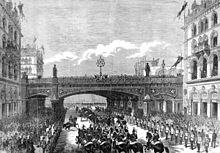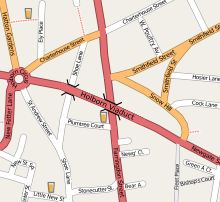Holborn Viaduct
The Holborn Viaduct is a road bridge in the City of London . On the bridge, the street of the same name (as part of the A40 ) crosses Farringdon Street and connects Holborn, via Holborn Circus, with Newgate Street in the city. The 24 m wide viaduct spans from the higher Holborn Hill the valley of the River Fleet, which now runs underground, with a length of 430 m and has been converted by buildings on both sides.
The bridge was built between 1863 and 1869 as part of the Holborn Valley Improvements under the direction of William Haywood and engineer Rowland Mason Ordish . This £ 2m (equivalent to around £ 181m in 2018) public works program aimed to improve traffic flow and access from the West End to the City. In addition to the viaduct, the program included the creation of Holborn Circus and Queen Victoria Street, the rebuilding of Blackfriars Bridge, and the continuation of Farringdon Street and the creation of Farringdon and Ludgate Hill stations . On November 6, 1869, the viaduct, along with the other streets, was opened by Queen Victoria with a formal carriage parade.
The viaduct was intended to provide a more level ride from west to east across the Fleet Valley and Farringdon Street. Previously, horse-drawn carriages had to drive down from Holborn Hill along Charterhouse Street to the smaller Holborn Bridge in order to cross the River Fleet, which has been underground since 1734, near Ludgate Circus and climb Snow Hill on the opposite side. The bridge was one of the first modern overpasses in central London.
The bridge is flanked on both sides by two five-story pavilions that contain stairwells and elevators that pedestrians can use to switch between the two street levels. The bridge itself is richly decorated and equipped with several statues. The sculptures created by Henry Bursill on the south side symbolize trade and agriculture, while those made by the Farmer & Brindley company represent science and the arts on the north side. In addition, there is a winged lion with a ball, also made of bronze, on each pavilion.
When London was bombed in World War II in 1941, large parts of this area and the two northern pavilions were destroyed. It was not until 2000 that the western building and in 2014 the eastern building could be restored in the context of real estate projects.
To the southeast of the bridge, the Holborn Viaduct station was opened in 1874 . In the eastern part it was a through station for the route towards Farringdon before it was replaced in 1990 by City Thameslink station.
One of the world's first coal-fired power plants opened north-west of the bridge in 1882 .
Web links
Individual evidence
- ↑ James Stevens Curl: Ordish, Rowland Mason . In: A Dictionary of Architecture and Landscape Architecture . Encyclopedia.com. Retrieved June 29, 2012.
- ↑ 'The Farringdon Wards of the City of London a ... history' pp. 2-10, by Tony Sharp, London 2002 Engineering timelines - Holborn Viaduct . Retrieved March 20, 2013.
Coordinates: 51 ° 31 ′ 2.1 ″ N , 0 ° 6 ′ 18.3 ″ W.


